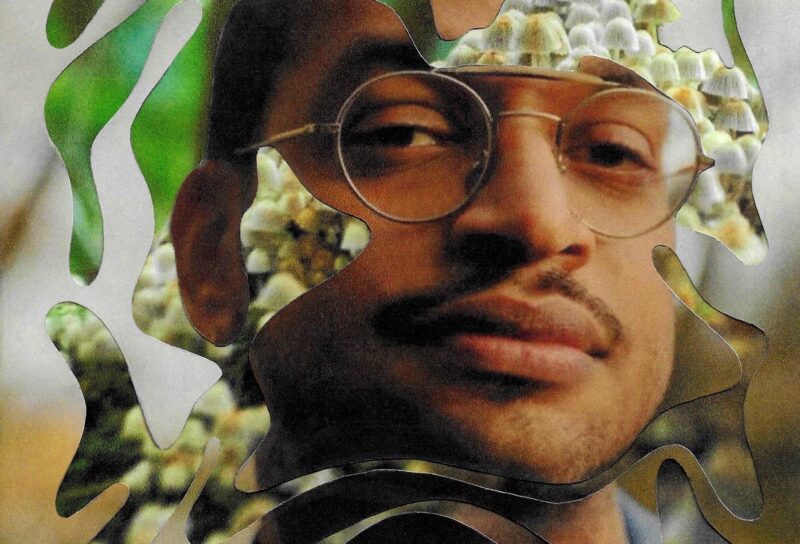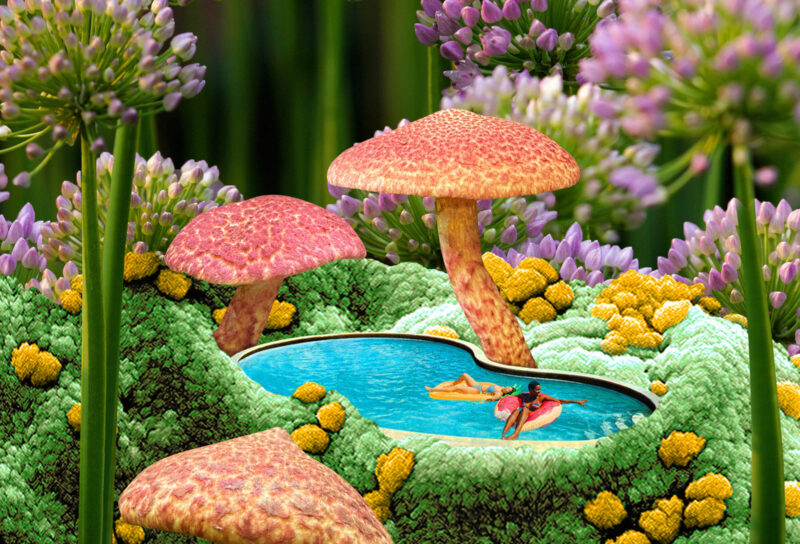It begins, as everything does, with some seeds.
Wildflowers, a local blend of California poppies, lupines, and tidy tips. I sowed them five years ago, in November. The following February, they began to sprout, and by April the wildflower patch was a painting — its lazy splashes of orange, yellow and purple bowing in the spring breeze. With every season, it has bloomed, died, re-sown itself, disappeared and returned, its colors and dimensions shifting with the year’s offerings of sun and rain, welcoming drunken bees, lizards, migrating birds, and butterflies. A few years ago, the flowers left the back garden and appeared in the concrete median in front of my house, following the sun.
Not far from where I live, the spring rains will soon awaken bright orange fields of wild California poppies in the wind-swept Antelope Valley. Already, the local communities have signaled they will forbid visitors to come and see them. Social media has transformed this once-bucolic annual pilgrimage; over the last few years, as Instagram has swelled with floral selfies, the country roads leading to the blooms have swollen with cars and the detritus left behind by inconsiderate tourists. Nearby rural communities, unable to support the chaos of “Disneyland-sized” crowds, have suffered, as have the flowers, whose delicate habitats are irrevocably destroyed by influencers making snow angels in the bloom.
Here is the difference between growth and scalability: on one hand, an unruly seasonal explosion of flowers, on the other, the algorithmically-boosted presentation of those same flowers as a product, a highly-reproducible image driving traffic both online and onto California State Route 14. In the Antelope Valley and in my back garden, wildflowers adapt to the season. They map the sun onto the land. They come and go. Online, the poppy is detached from place. It has become a sea of orange to monetize. The monolithic ubiquity of the poppy field as an image is inversely correlated to the ephemeral poppy itself, which wilts as soon as it is picked.
Tilting the Scale
“Scalability is not an ordinary feature of nature,” writes the anthropologist Anna Lowenhaupt Tsing in The Mushroom at the End of the World, her ethnography charting the relationships between Matsutake mushrooms and the humans who forage, consume, and study them. Like poppies, Matsutake are highly valuable commodities. They, too, resist cultivation, thriving only in the ruins of the logging industry, in decimated North American forests. They are nonscalable, like everything in the natural world, because they don’t grow alone. Like poppies, which are part of a larger grassland habitat, a mosaic of owl’s clover, lupine, goldfield, cream cups, and coreopsis flowers, Tsing’s mushrooms thrive in a mutualistic relationship with forest trees, foraging nutrients from the soil in exchange for carbohydrates. These encounters are a catalyst for diversity — and, through them, growth is a process of entanglement and mutual transformation. As Tsing observes in her work, nothing living expands without changing in some way.
What the business world calls “scalability,” however, is precisely the capacity to expand without change, like a fractal — or a fast food franchise. A scalable business can be easily reproduced, because its internal mechanisms maintain their efficiency, and their profitability, regardless of context: the hamburger tastes exactly the same, and is prepared just as quickly, at every McDonald’s in the country. New franchises add no complexity to such an organization; they simply make a reproducible, economically-efficient system bigger. In the name of progress, Tsing observes, we call such expansion “growth,” as though we were speaking of something alive. But it’s not alive; it’s a cousin of death, and it has made life, with its nonscalable elements — poppies, mushrooms, stubborn bacteria — seem like an impediment, a spanner in the works grinding the great churn of expansion to a halt. The great Canadian physicist and educator Ursula Franklin makes a similar observation in her book The Real World of Technology, contrasting “growth models,” systems in which things develop naturally to an appropriate size and scale, with “production models,” systems in which things are produced under controlled, predictable parameters. The key distinction: “growth occurs,” Franklin writes. “It is not made.”
The fact that scalability is unnatural doesn’t mean it is impossible to impose on the natural world. Tsing cites European sugarcane plantations as “early and influential icons” of scalability; by razing local land and importing cloned plants and enslaved Africans, colonial powers excised all social and ecological relations from the process of farming cane. Every element of the plantation was alienated, and thus interchangeable, and the whole system could be easily reproduced, maximizing profit. This model — alienated labor producing commodities without context — influenced early industrialization, and big business has since remade our once-diverse planet in its image, plowing forests into feedlots and factories. These systems “banish meaningful diversity,” writes Tsing, “which is to say, diversity that might change things.” But even the most efficient and ostensibly reproducible production line exists in a social and ecological reality. Indeed, it’s only by shunting away responsibility for externalities like waste, the physical and mental health of workers, or the depletion of nonrenewable resources, and by stripping context from all its component parts that an enterprise can be made scalable to begin with.
Mass production depletes resources quickly, and inevitably. As Tsing writes, “scalability spreads — and yet it is constantly abandoned, leaving ruins,” like the decimated timber stands where Matsutake now thrive. Scalability is an illusion deemed essential for the maintenance of our contemporary political economy. Investors seek business opportunities with “room to grow,” upper limits be damned. Even the products of fundamentally nonscalable processes, like wildflowers or foraged Matsutake mushrooms, are eventually sorted, weighed, tallied, and sold in a global marketplace, as objects or images of value. In the course of that process, they are reduced to anonymous units, no different from factory-made Christmas ornaments or unripe bananas, all ghosts in the supply chain. The machine eats them all up, as it will eat us all up, if we let it.
I am a tumult of cells and bacteria; I am a speck of dust in the cosmos; I am 5’9” and walking along the trail towards a glowing orange poppy field, all at once.
Technology has habituated us to an unnatural experience of scale. We pinch and zoom, enlarging and diminishing everything we touch, seduced by a sense of godlike omniscience over the world’s vastness. As a recent atmospheric river of rain fell on Southern California — the wildflowers will be remarkable this year — I spent an afternoon indoors, listening to talks on YouTube from a 2022 academic conference on scale. Nearly every scholar, regardless of discipline, mentioned Google Earth in some capacity: a technology whose instantaneous, real-time planetary zoom has irrevocably scrambled the way we think about scale. It’s tempting to zoom from Google Earth’s planetary view down to the bare pixel and believe what the journey tells us: that the real world fits in our pockets, and on our terms.
As we zoom, we never change size: we are always giants, looking upon our dwindling territory. Anna Lowenhaupt Tsing calls these shifts “precision-nested scales,” a computationally anthropocentric view of reality undergirded by pixels, units that must “remain uniform, separate, and autonomous.” Pixels only ever lend the illusion, from a distance, of blending into one another to create a coherent image. But even though biologists (and synthetic biologists) often speak of the “building blocks of life,” real life does not work that way. It’s not built, Minecraft style, from pixelated protoplasm; it’s a process of dynamic and transformative interrelations, which are porous down to the atom.
From the Bottom Up
The reason I tuned into that YouTube conference on scale was to watch a talk by the Italian nanotechnologist Laura Tripaldi, author of a beguiling book, Parallel Minds, about the intelligence of materials. In her talk, Tripaldi explained that rigid boundaries between surfaces simply do not exist. Observed under magnification, at the level of chemical interactions, the place where two materials meet is never a hard line, but rather “a material space where the properties of the two bodies mix with one another.” Nanotechnologists do not talk about surfaces, she said. Instead, they talk about interfaces, which are sites of encounter. In these interfaces, materials come together and arrange themselves into new, hybrid states of matter. This is not some rare phenomenon. In fact everything mixes. In our interactions with the material world, we may only ever touch the surface of things — but it is a “three-dimensional and dynamic surface, capable of penetrating both the object before us and the inside of our own bodies.”1 Materials science, like biology, teaches us that nothing exists in isolation, and that things — both “dead” and alive — constantly and actively negotiate with one another. Scalability ignores these negotiations. As a process that presumes its individual elements to be discrete, uniform, nonporous, and interchangeable, it is alien to both biological and material reality. Like the conflation of expansion and growth, it is a social and economic construction.
In Parallel Minds, Tripaldi points out that at the nanoscale, matter is “sticky.” Any object used to manipulate atoms directly is made of atoms itself, and atoms are squirrelly, imbued with kinetic energy and animated by electrostatic interactions. This is why, contrary to the popular understanding of nanotechnology as a domain of microscopic assembler robots and nanoscale tweezers, most nanotechnologists prefer to let matter arrange itself. In living and chemical systems, atoms, molecules, and particles regularly organize themselves into complex structures from within. From a jumble of chemical ingredients, cells split, plants grow, and crystals emerge in their perfect symmetry. Understanding and harnessing bottom-up self-assembly has become a central pursuit of modern nanotechnology, indicating an approach to technology, science, and even industrial production that emulates rather than banishes natural processes of growth.
In this, the nanotechnologists are not alone. Iconoclastic biologists, like Tufts University’s Michael Levin, are equally fascinated by the processes by which living things come together — the morphogenesis that transforms matter into complex living systems that can self-repair, adapt, and even think. They’re joined by those rogue computer scientists crafting “unconventional computing” systems from slime mold and fungal mycelia; by roboticists working with soft, sensitive, and even living materials; by Artificial Life researchers who seek to emulate evolutionary and emergent behaviors in silico; and by molecular “pharmers” working to produce useful pharmaceutical and industrial compounds in plants like maize, rice, and barley. The living world simply does things well, and it’s often easier to crib from the useful properties of natural systems than it is to start from scratch.
Life is nonhierarchical, and it shirks top-down control. But scalability relies on hierarchy, on the isolation of elements stripped of history and context. It is predicated on the assumption that nature is little more than a raw material to be processed and commodified until it is spent. This is, of course, unsustainable — at any scale. So what is the alternative? Can we redefine “scalability” as a process as dense, complex, and generative as the living world? And more pointedly, could synthetic biology grow, rather than scale, benefiting the communities and ecosystems it impacts without the ruinous damage of its industrial predecessors?
Synthetic biology is still a young science, its capacity to engineer life largely limited to the individual cell. But as that capacity scales to the organism, and eventually, perhaps, to the ecosystem, it would do well to model itself on the example set by the living world. Nature takes a collaborative approach to survival; in industry, a focus on product, and the product’s uniqueness as property, tends to prevent the potentially fruitful cross-contamination of ideas. Further, as recent advances in applying machine learning to thorny biological problems like protein structure has shown, the possibility space for life is almost immeasurably vast. In synthetic biology, the way forward may not be a matter of producing at scale but rather inquiring at scale, changing the volume at which we converse with the living world before deciding what to assemble, rather than mine, maul, or murder. This bottom-up strategy promises to upend the extractive, alienating production models that have caused so much harm: no need for factory farms if we can engineer microbes to synthesize our burgers. But as I have written before in this magazine, microbes are people too, and if we don’t approach them with care, conscious of our own existing entanglements with them, we will simply repeat those same extractive processes in miniature.
The media theorist Zachary Horton, in his book The Cosmic Zoom, defines scale as an “ethical ground that binds individuals, groups, and territories into interconnected milieus of interdependence and responsibility.” Although it can often feel as though we live on the knife’s edge between the inconceivably large — climate change, big data — and the vanishingly small — deadly viruses, toxic particles — scale is not linear. I am a tumult of cells and bacteria; I am a speck of dust in the cosmos; I am 5’9” and walking along the trail towards a glowing orange poppy field, all at once. Considering scale as an ethical ground, as Horton suggests, requires awareness of these nested and simultaneous realities — and most importantly, of their reliance on one another. When we act upon the seed, we act upon the meadow, and we act upon the world. Let’s sow carefully, and follow the sun.
1Laura Tripaldi, Parallel Minds: Discovering the Intelligence of Materials, MIT Press, 3.



